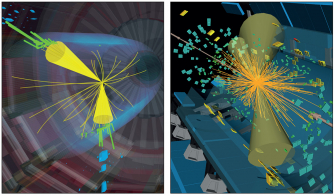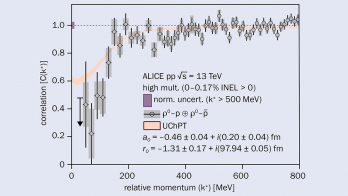
The second harmonic – v2, which is also known as the elliptic-flow coefficient – has recently been the main focus of the heavy-ion community. Indeed, elliptic-flow measurements and hydrodynamical calculations led to the revelation that the quark–gluon plasma (QGP) generated in heavy-ion collisions behaves as an almost perfect liquid. The ratio of shear viscosity to entropy density (η/s) in the QGP, which is a measure of its fluidity, is very close to the lower bound of ħ/4π kB – as conjectured by the anti-de-Sitter/conformal field theory (AdS/CFT) correspondence.
However, there are also higher-order contributions to the particle correlations and these are more sensitive probes of the QGP state than elliptic flow. Indeed, by carrying out such studies for identified particles rather than unidentified ones, it is also possible to probe the effect of the dissipative, late-stage hadronic re-scattering on the flow coefficients.
Profiting from its excellent particle-identification capabilities, the ALICE collaboration has recently used lead–lead collisions recorded in 2011 at a collision energy of 2.76 TeV to measure the elliptic (v2), triangular (v3), quadrangular (v4) and pentagonal (v5) flow coefficients of charged π and K mesons, protons and antiprotons for different centrality intervals (see figure). For ultra-central collisions, in which the evolution of the system is predominantly driven by the initial-state fluctuations, one observes significant nonzero values for all harmonics and particle species. In addition, v3 and v4 become progressively dominant with increasing transverse momentum, while even v5 for pT > 4 GeV/c is comparable to v2. For mid-central collisions, v2 is the dominant flow harmonic and has a significantly larger value. Higher harmonics also have significant nonzero values but do not seem to change significantly with centrality.
These observations confirm that elliptic flow is driven mainly by the anisotropy in the collision geometry, whereas the initial-state fluctuations are the main driving force behind higher harmonics. A mass ordering expected in hydrodynamical calculations is seen that describes the QGP as a nearly perfect liquid. In addition, in the intermediate-pT region, the flow harmonics of different hadrons show a baryon–meson grouping. The analysis of lead–lead collisions collected in 2015 will allow for a higher-precision measurement of such effects and therefore place more stringent limits on η/s and the initial conditions of a heavy-ion collision.







